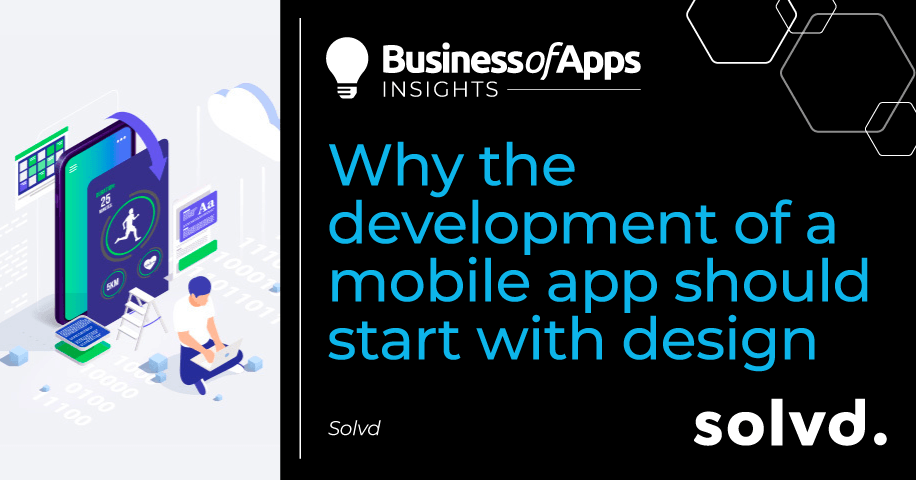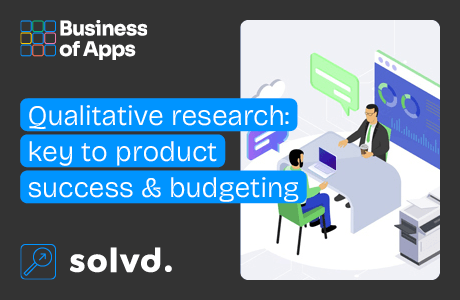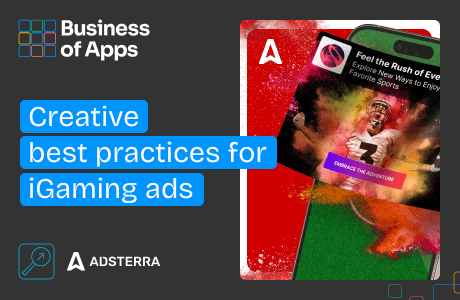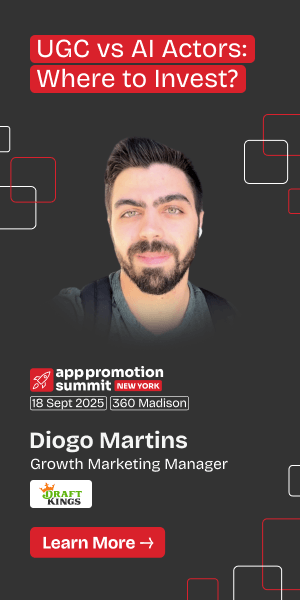When Big Tech companies introduce a new app or service within their customer infrastructure, they often use the fail-fast strategy: releasing an MVP as early as humanly possible and watching if it takes off or drowns (and changing it accordingly). An MVP is often a product where design takes the second place after functionality, so teams work on design-related issues when they already have initial feedback from customers or focus groups.
This strategy is totally justifiable for Big Tech – they can afford a failure and they will recover from it quickly, and it can be very informative; and while this approach has its advantages, it’s not always the best solution for smaller-scale projects. In my experience, neglecting design-related issues is one of the most prominent reasons why new mobile or web-based application launches fail. Fixing those issues often doesn’t provide the expected results, as companies that don’t belong to Big Tech usually don’t have that second chance.
Steve Jobs, admittedly the most listened-to voice in UI/UX design of our time, once said: “You‘ve got to start with the customer experience and work back toward the technology – not the other way around.” I would say, this perfectly sums up the way I see the role of UI/UX design in the development of a good mobile or web-based application or any human interaction.
Let me elaborate on that. The process of development itself is crucial in the making of an application, but design adds to it the value developers usually can’t. Design really isn’t about what an app does. It’s about how it does it, how convenient it is for the user, and how enjoyable (or not) the user finds the experience of working with the app. What’s the purpose of using it?
A UI/UX designer has a bird’s eye view of the project, which is often inaccessible for regular developers because they need to dive very deep into their designated tasks. This specific point of view a designer brings at the initial stages of development may play a decisive role in how the development goes. Let’s take a closer look at why working with a designer is especially important when the project is just kicking off.
The what vs. the how
When planning a new app, the most important question a development team needs to address is functionality. What features will the app have, and what will it be capable of doing? But the truth is, this is only one side of the coin. Turn the coin, and we have the designer’s input. A designer takes the ‘what it should do’ in terms of the future app features and adds their ‘how it should do it’. In other words, a designer thinks about whether or not using the app is going to be easy, comfortable and enjoyable for the user.
I adhere to the point of view that a designer should always first and foremost be advocating for users. If an application has a great feature, it’s half the business. If the feature is not intuitive, not easily accessible, and has a big learning curve, it may frustrate users and it will not add to the value of the application. Developers often may not see these things, because their in-depth knowledge of what’s under the hood of the application creates the job conditioning effect. This is why the view of a designer is so important.
I like to compare my approach to design to the anatomic structure of a living being:
- There are BONES, which is the information architecture of the future app. It is the carcass on which everything else is built. When a designer creates the information architecture, they provide a high-level view of user problems the app needs to solve, and ultimately, create the app navigation system. With navigation being the core, developers, QA engineers and other teams are able to build on it keeping their work consistent throughout.
- User flows and software logic could be viewed as the MUSCLES of that organism and visual UI design as the SKIN. If we look at it this way, we can see that design is important at every level of software development.
Why UI and UX design can’t be substituted by business analysis
In my line of work, I have encountered projects where the general leadership consensus could be something like “But we have very detailed acceptance criteria and customer requirements, what’s the point of doing UI and/or UX design?” More often than not, they ended up doing UI/UX design anyways, but at stages where an app required multiple fixes that could have been avoided, thus, losing development time and spending extra.
It is a common mistake to think that acceptance criteria and customer requirements provide a full picture of what the future product should look like and how it should work. In fact, it’s much more complicated than that. Acceptance Criteria for a developer’s task ideally should be based on the validated design.
A customer can have a clear view of what they want in the end, but even behind a simple action of pressing a button, there could be a whole sequence of actions the app makes. These actions are invisible to the end-user, they should stay under the hood, but when a customer transfers their view of what they want to see as end-users, they don’t consider these actions. And it’s not your customer’s job to provide this hidden logic.
I think there’s one other aspect that should be considered before the development of a new app starts, and it is research. Although carrying out extensive and thorough research is invaluable, research takes time, it’s expensive and not every project has the budget to do it full-scale. A UX designer can provide primary research data because we do it anyway when designing an app. As a designer, I gather information about the target audience, their pains and needs, and problems that they are willing to solve commercially.
I identify key tasks a user completes within the app, I get interviews done with customers and end-users and validate various hypotheses. Of course, there are other methods as well. This information helps me draw accurate user archetypes and consider user behavior and preferences but other team members will benefit from it as well.
Working with an MVP
It often happens that having a basic MVP and accelerating it to the market is what companies do to gather the first feedback as soon as possible and plan updates and fixes accordingly, without a design process. It may seem that user feedback can improve usability, but it can actually be quite misleading.
If users point to a flaw or a problem, they can envision how they want it solved, but they may easily lack knowledge about how it should actually be solved. Moreover, the root of the problem may be entirely different from what the user identifies it to be because a user doesn’t have to look into the causes, they report consequences. A UI/UX designer has the necessary skills not only to correctly pinpoint problems using customer feedback but also to offer wholesome solutions.
One thing that a good UI/UX designer does is infiltrate every nook and cranny of the application to see how it performs in terms of usability. I’d like to reiterate that this high-level view is similar to that of a user and opposite to that of a developer, and this is why it is valuable. This is why a designer’s evaluation of an MVP is crucial.
Why working with a UI/UX designer early on is cost-effective
Investing in a properly done design system can save a lot of trouble for the entire team and ease and speed up many development and QA processes.
I think proper UI and UX design has the following cost-effective factors:
Early prevention of issues
A designer’s focus on a seamless user journey allows them to locate and address multiple usability issues early on, thus improving customer satisfaction rate.
Consistency of visual language
User-facing workflows, and software logic that a UX designer works on, give the other teams an even clearer picture of what should be developed, with a transparent view of how it should work in mind. This approach may in fact significantly ease and systemize the developers’ work, eliminating a lot of unnecessary effort and thus, cutting the development costs and timing.
Scalability and reduced redesign and update costs
When a designer works on style books and branding elements, they introduce a scalable molecular structure – we do it that way. It allows for a much smoother addition of new elements. A well-made design system allows you to add to your app without unmaking or reducing what’s previously been done, helps with simpler updates and redesigns, and situational branding which reduces their development cost.
Improved QA
A designer can provide an additional point of view for the QA team, as they know how a user perceives the product, and tend to look at all the product business processes from the end-user’s point of view. It can save more money than you assume.
Improved user retention
Because a UI/UX designer’s input is to make your app consider as many customer needs and preferences, it also increases the chances that a user will come back to use your app or service again and again. This can not only reduce user acquisition costs but also generally increase the revenue your app generates.
How a UI/UX designer helps developers consider industry specifics
I think it’s common knowledge that industry-tailored apps usually do much better than generic apps. People need applications that do similar things across a multitude of industries, but target audiences in different industries can differ drastically and offering them similar solutions would be a big mistake.
It is a designer’s job to study commercial habits, location specifics and emotional behaviors of the target audience and tailor the solutions within the app for them. Thus, in an e-commerce app, making payments should often include cryptocurrency support and considerations for local cryptocurrency regulations. A fitness app, in order to have higher customer satisfaction rates, should integrate and support a variety of third-party products, such as trackers, nutrition apps, wearable devices, etc.
These things make your app more successful with your target audience, and a UI/UX designer helps to identify them. A designer draws a definite line between the needs of a business area and the needs of a user and designs an app with a user point of view in mind, but taking into consideration the business area specifics.
Conclusion, or what makes a good UI/UX designer
Now that we have established that having a UI/UX designer on the team from the very start is beneficial for your project in a number of ways.
A good designer is not just about mockups and interfaces
A good designer is a great communicator, as their input is something that should enhance the work of all other teams. A good designer has an established rapport with the target audience, they understand their pains and needs, likes and preferences, and can communicate this information to the development team, translating it into a solid systematic design.
A good designer always tends to dig deeper
It is vital that a UI/UX designer is willing to get down to the very essence of all things in the application, to understand every logic, to grasp all cause-and-effect relationships. This approach allows for better product clarity on all levels and mitigates a large number of miscommunication risks.
In my experience, observing these qualities makes a designer an invaluable member of a development project and helps ensure that your final product meets the expectations of your customer and the needs of your users.











